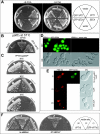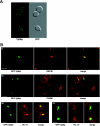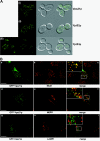Bioinformatic and comparative localization of Rab proteins reveals functional insights into the uncharacterized GTPases Ypt10p and Ypt11p
- PMID: 16980630
- PMCID: PMC1592887
- DOI: 10.1128/MCB.02405-05
Bioinformatic and comparative localization of Rab proteins reveals functional insights into the uncharacterized GTPases Ypt10p and Ypt11p
Abstract
A striking characteristic of a Rab protein is its steady-state localization to the cytosolic surface of a particular subcellular membrane. In this study, we have undertaken a combined bioinformatic and experimental approach to examine the evolutionary conservation of Rab protein localization. A comprehensive primary sequence classification shows that 10 out of the 11 Rab proteins identified in the yeast (Saccharomyces cerevisiae) genome can be grouped within a major subclass, each comprising multiple Rab orthologs from diverse species. We compared the locations of individual yeast Rab proteins with their localizations following ectopic expression in mammalian cells. Our results suggest that green fluorescent protein-tagged Rab proteins maintain localizations across large evolutionary distances and that the major known player in the Rab localization pathway, mammalian Rab-GDI, is able to function in yeast. These findings enable us to provide insight into novel gene functions and classify the uncharacterized Rab proteins Ypt10p (YBR264C) as being involved in endocytic function and Ypt11p (YNL304W) as being localized to the endoplasmic reticulum, where we demonstrate it is required for organelle inheritance.
Figures











References
-
- Ali, B. R., and M. C. Seabra. 2005. Targeting of Rab GTPases to cellular membranes. Biochem. Soc. Trans. 33:652-656. - PubMed
-
- Ali, B. R., C. Wasmeier, L. Lamoreux, M. Strom, and M. C. Seabra. 2004. Multiple regions contribute to membrane targeting of Rab GTPases. J. Cell Sci. 117:6401-6412. - PubMed
-
- Bereiter-Hahn, J. 1990. Behavior of mitochondria in the living cell. Int. Rev. Cytol. 122:1-63. - PubMed
Publication types
MeSH terms
Substances
LinkOut - more resources
Full Text Sources
Molecular Biology Databases
